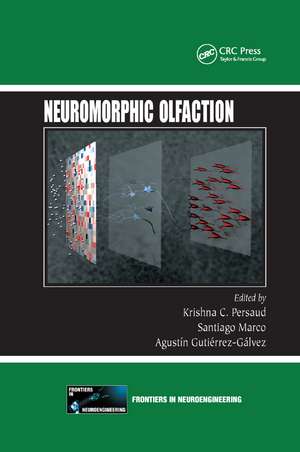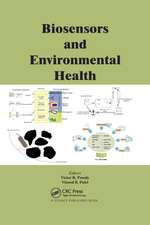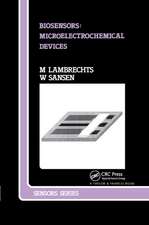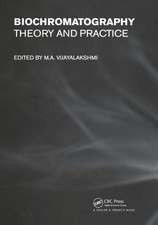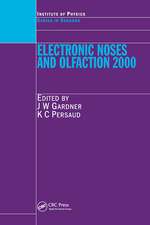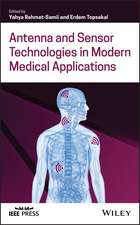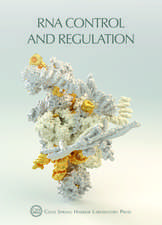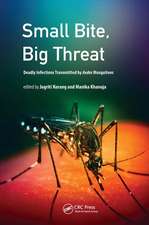Neuromorphic Olfaction
Editat de Krishna C. Persaud, Santiago Marco, Agustin Gutierrez-Galvezen Limba Engleză Paperback – 24 oct 2019
Developing neuromorphic olfaction from conceptual points of view to practical applications, this cross-disciplinary book examines:
- The biological components of vertebrate and invertebrate chemical sensing systems
- The early coding pathways in the biological olfactory system, showing how nonspecific receptor populations may have significant advantages in encoding odor intensity as well as odor identity
- The redundancy and the massive convergence of the olfactory receptor neurons to the olfactory bulb
- A neuromorphic approach to artificial olfaction in robots
- Reactive and cognitive search strategies for olfactory robots
- The implementation of a computational model of the mammalian olfactory system
The book’s primary focus is on translating aspects of olfaction into computationally practical algorithms. These algorithms can help us understand the underlying behavior of the chemical senses in biological systems. They can also be translated into practical applications, such as robotic navigation and systems for uniquely detecting chemical species in a complex background.
| Toate formatele și edițiile | Preț | Express |
|---|---|---|
| Paperback (1) | 369.99 lei 6-8 săpt. | |
| CRC Press – 24 oct 2019 | 369.99 lei 6-8 săpt. | |
| Hardback (1) | 986.91 lei 6-8 săpt. | |
| CRC Press – 23 apr 2013 | 986.91 lei 6-8 săpt. |
Preț: 369.99 lei
Preț vechi: 477.07 lei
-22% Nou
Puncte Express: 555
Preț estimativ în valută:
70.82€ • 76.95$ • 59.53£
70.82€ • 76.95$ • 59.53£
Carte tipărită la comandă
Livrare economică 21 aprilie-05 mai
Preluare comenzi: 021 569.72.76
Specificații
ISBN-13: 9780367380151
ISBN-10: 0367380153
Pagini: 238
Dimensiuni: 156 x 234 mm
Greutate: 0.44 kg
Ediția:1
Editura: CRC Press
Colecția CRC Press
ISBN-10: 0367380153
Pagini: 238
Dimensiuni: 156 x 234 mm
Greutate: 0.44 kg
Ediția:1
Editura: CRC Press
Colecția CRC Press
Public țintă
Academic and Professional Practice & DevelopmentCuprins
Engineering Aspects of Olfaction. Study of the Coding Efficiency of Populations of Olfactory Receptor Neurons and Olfactory Glomeruli. Mimicking Biological Olfaction with Very Large Chemical Arrays. The Synthetic Moth: A Neuromorphic Approach toward Artificial Olfaction in Robots. Reactive and Cognitive Search Strategies for Olfactory Robots. Performance of a Computational Model of the Mammalian Olfactory System. Index.
Notă biografică
Krishna Persaud has been involved in research in chemoreception, crossing disciplines from biological aspects of olfaction to sensor arrays, electronics, signal processing and pattern recognition, and commercial development of artificial olfaction technologies.
Santiago Marco’s research concerns the development of signal/ data processing algorithmic solutions for smart chemical sensing based in sensor arrays or microspectrometers integrated with Microsystem Technologies.
Agustín Gutiérrez-Gálvez’s research interests include biologically inspired processing for gas sensor arrays, computational models of the olfactory system, pattern recognition, and dynamical systems.
Santiago Marco’s research concerns the development of signal/ data processing algorithmic solutions for smart chemical sensing based in sensor arrays or microspectrometers integrated with Microsystem Technologies.
Agustín Gutiérrez-Gálvez’s research interests include biologically inspired processing for gas sensor arrays, computational models of the olfactory system, pattern recognition, and dynamical systems.
Descriere
With biological components of chemical sensing systems becoming well understood in terms of their structure and function, it is now possible to consider biomimetic models of olfaction and how they may be translated into functional engineering devices. This book presents an innovative interdisciplinary biomimetic approach to olfaction, addressing biology, hardware, software, and sensors. The text explores contributions to the realization of novel chemical sensing systems inspired by biological pathways and describes cutting-edge research on engineering aspects of olfaction, odor coding of neurons, chemical sensor arrays, and biologically modeled sensor robots.
